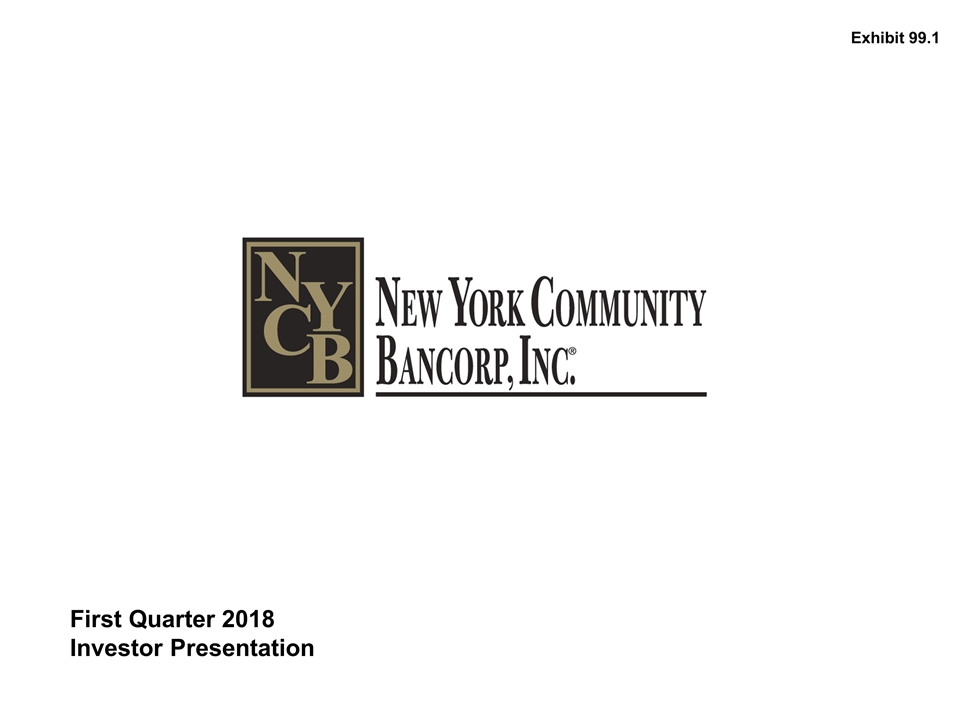
First Quarter 2018 Investor Presentation Exhibit 99.1
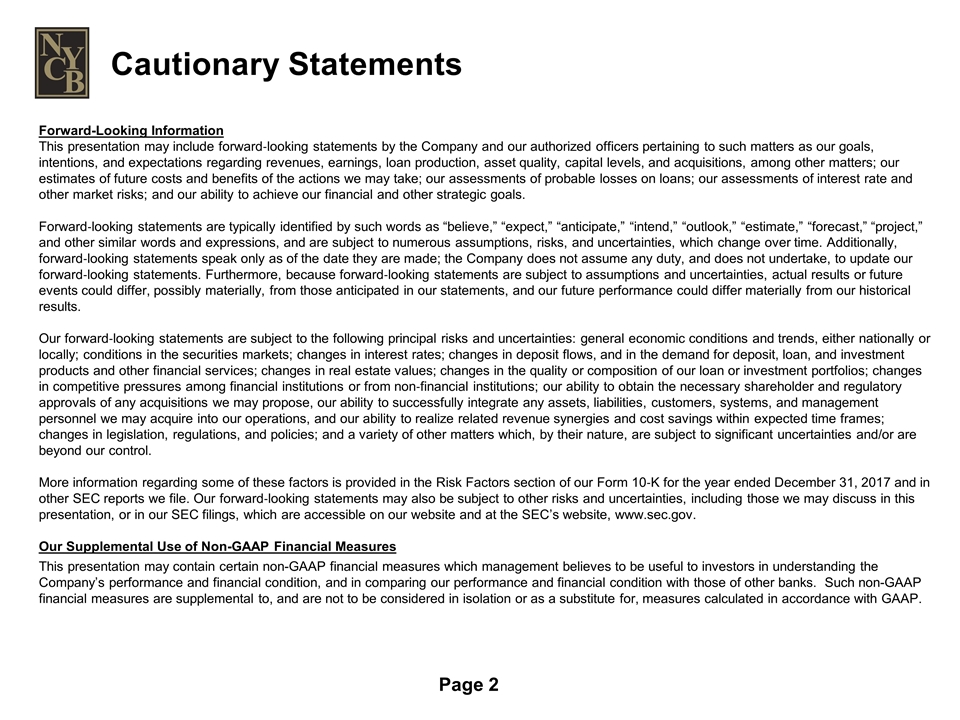
Forward-Looking Information This presentation may include forward‐looking statements by the Company and our authorized officers pertaining to such matters as our goals, intentions, and expectations regarding revenues, earnings, loan production, asset quality, capital levels, and acquisitions, among other matters; our estimates of future costs and benefits of the actions we may take; our assessments of probable losses on loans; our assessments of interest rate and other market risks; and our ability to achieve our financial and other strategic goals. Forward‐looking statements are typically identified by such words as “believe,” “expect,” “anticipate,” “intend,” “outlook,” “estimate,” “forecast,” “project,” and other similar words and expressions, and are subject to numerous assumptions, risks, and uncertainties, which change over time. Additionally, forward‐looking statements speak only as of the date they are made; the Company does not assume any duty, and does not undertake, to update our forward‐looking statements. Furthermore, because forward‐looking statements are subject to assumptions and uncertainties, actual results or future events could differ, possibly materially, from those anticipated in our statements, and our future performance could differ materially from our historical results. Our forward‐looking statements are subject to the following principal risks and uncertainties: general economic conditions and trends, either nationally or locally; conditions in the securities markets; changes in interest rates; changes in deposit flows, and in the demand for deposit, loan, and investment products and other financial services; changes in real estate values; changes in the quality or composition of our loan or investment portfolios; changes in competitive pressures among financial institutions or from non‐financial institutions; our ability to obtain the necessary shareholder and regulatory approvals of any acquisitions we may propose, our ability to successfully integrate any assets, liabilities, customers, systems, and management personnel we may acquire into our operations, and our ability to realize related revenue synergies and cost savings within expected time frames; changes in legislation, regulations, and policies; and a variety of other matters which, by their nature, are subject to significant uncertainties and/or are beyond our control. More information regarding some of these factors is provided in the Risk Factors section of our Form 10‐K for the year ended December 31, 2017 and in other SEC reports we file. Our forward‐looking statements may also be subject to other risks and uncertainties, including those we may discuss in this presentation, or in our SEC filings, which are accessible on our website and at the SEC’s website, www.sec.gov. Our Supplemental Use of Non-GAAP Financial Measures This presentation may contain certain non-GAAP financial measures which management believes to be useful to investors in understanding the Company’s performance and financial condition, and in comparing our performance and financial condition with those of other banks. Such non-GAAP financial measures are supplemental to, and are not to be considered in isolation or as a substitute for, measures calculated in accordance with GAAP. Cautionary Statements
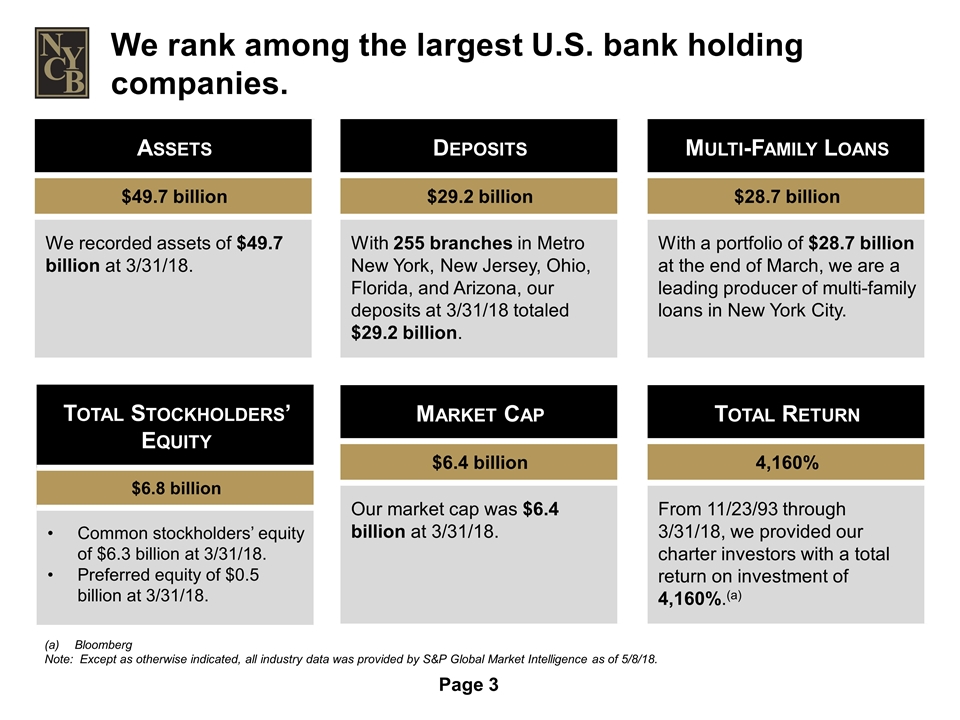
Assets $49.7 billion We recorded assets of $49.7 billion at 3/31/18. We rank among the largest U.S. bank holding companies. Bloomberg Note: Except as otherwise indicated, all industry data was provided by S&P Global Market Intelligence as of 5/8/18. Deposits $29.2 billion With 255 branches in Metro New York, New Jersey, Ohio, Florida, and Arizona, our deposits at 3/31/18 totaled $29.2 billion. Multi-Family Loans $28.7 billion With a portfolio of $28.7 billion at the end of March, we are a leading producer of multi-family loans in New York City. Total Stockholders’ Equity $6.8 billion Common stockholders’ equity of $6.3 billion at 3/31/18. Preferred equity of $0.5 billion at 3/31/18. Market Cap $6.4 billion Our market cap was $6.4 billion at 3/31/18. Total Return 4,160% From 11/23/93 through 3/31/18, we provided our charter investors with a total return on investment of 4,160%.(a)
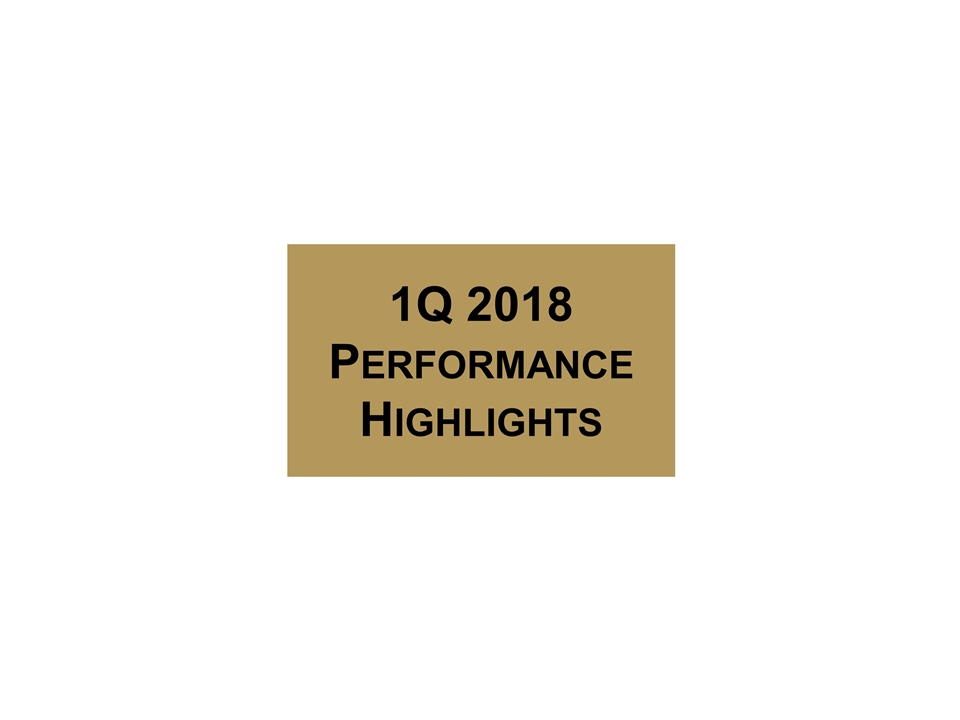
1Q 2018 Performance Highlights
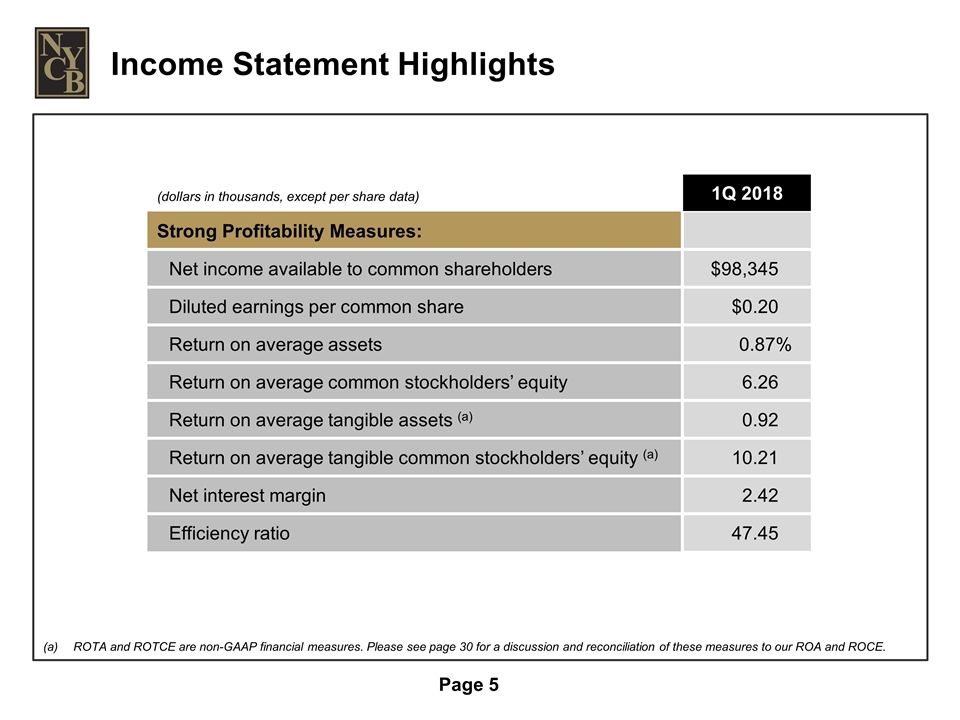
(dollars in thousands, except per share data) 1Q 2018 Strong Profitability Measures: Net income available to common shareholders $98,345 Diluted earnings per common share $0.20 Return on average assets 0.87% Return on average common stockholders’ equity 6.26 Return on average tangible assets (a) 0.92 Return on average tangible common stockholders’ equity (a) 10.21 Net interest margin 2.42 Efficiency ratio 47.45 Income Statement Highlights ROTA and ROTCE are non-GAAP financial measures. Please see page 30 for a discussion and reconciliation of these measures to our ROA and ROCE.
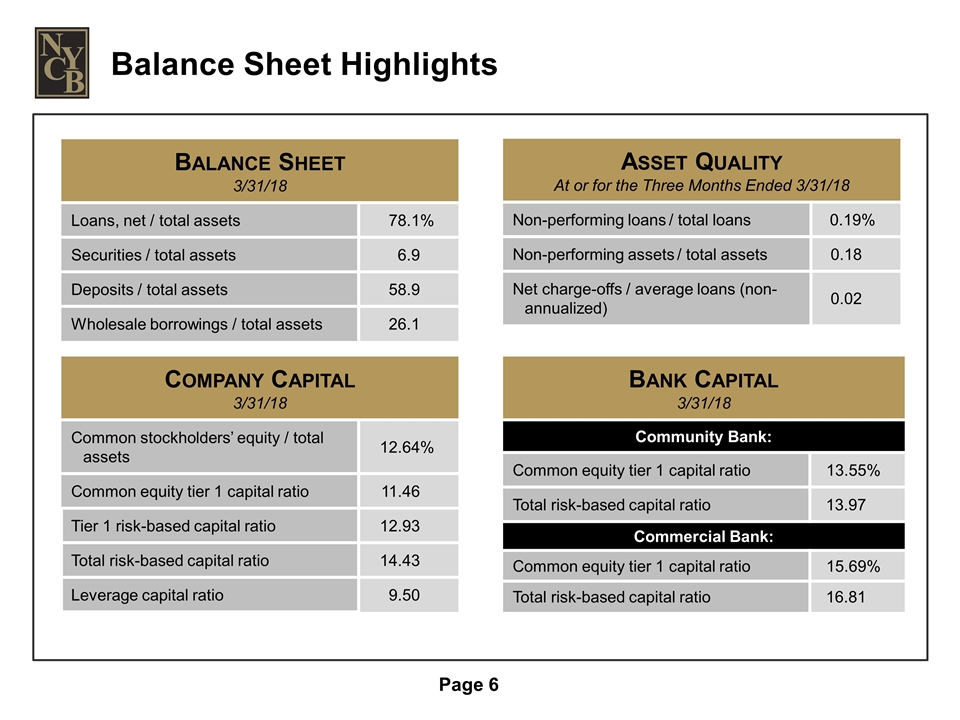
Company Capital 3/31/18 Common stockholders’ equity / total assets 12.64% Common equity tier 1 capital ratio 11.46 Tier 1 risk-based capital ratio 12.93 Total risk-based capital ratio 14.43 Leverage capital ratio 9.50 Bank Capital 3/31/18 Community Bank: Common equity tier 1 capital ratio 13.55% Total risk-based capital ratio 13.97 Commercial Bank: Common equity tier 1 capital ratio 15.69% Total risk-based capital ratio 16.81 Balance Sheet 3/31/18 Loans, net / total assets 78.1% Securities / total assets 6.9 Deposits / total assets 58.9 Wholesale borrowings / total assets 26.1 Asset Quality At or for the Three Months Ended 3/31/18 Non-performing loans / total loans 0.19% Non-performing assets / total assets 0.18 Net charge-offs / average loans (non-annualized) 0.02 Balance Sheet Highlights
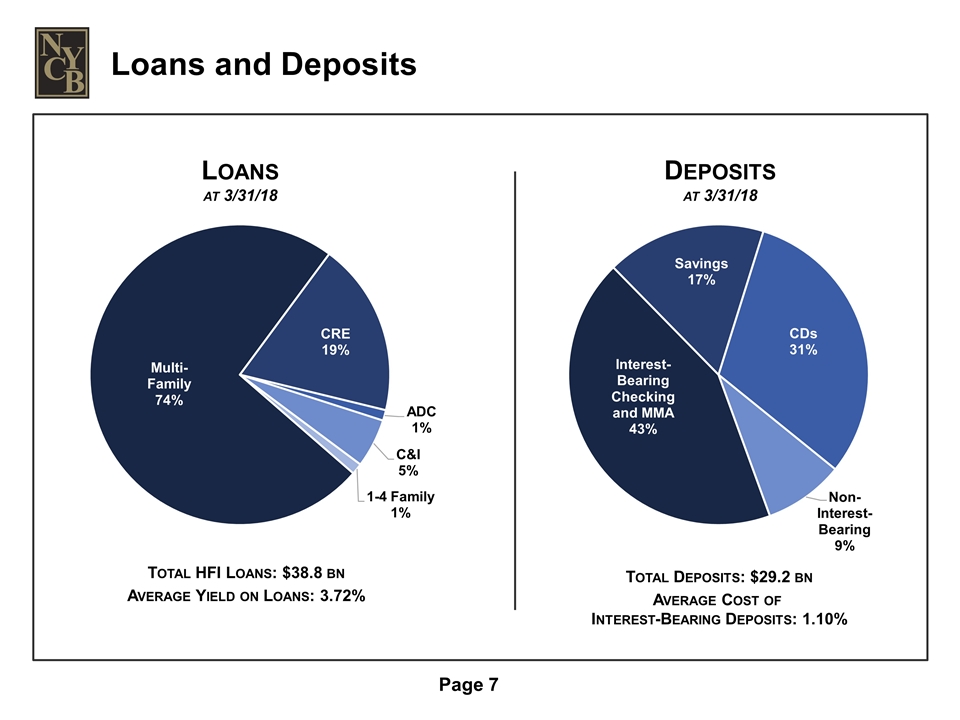
Total HFI Loans: $38.8 bn Average Yield on Loans: 3.72% Total Deposits: $29.2 bn Average Cost of Interest-Bearing Deposits: 1.10% Loans at 3/31/18 Deposits at 3/31/18 Loans and Deposits
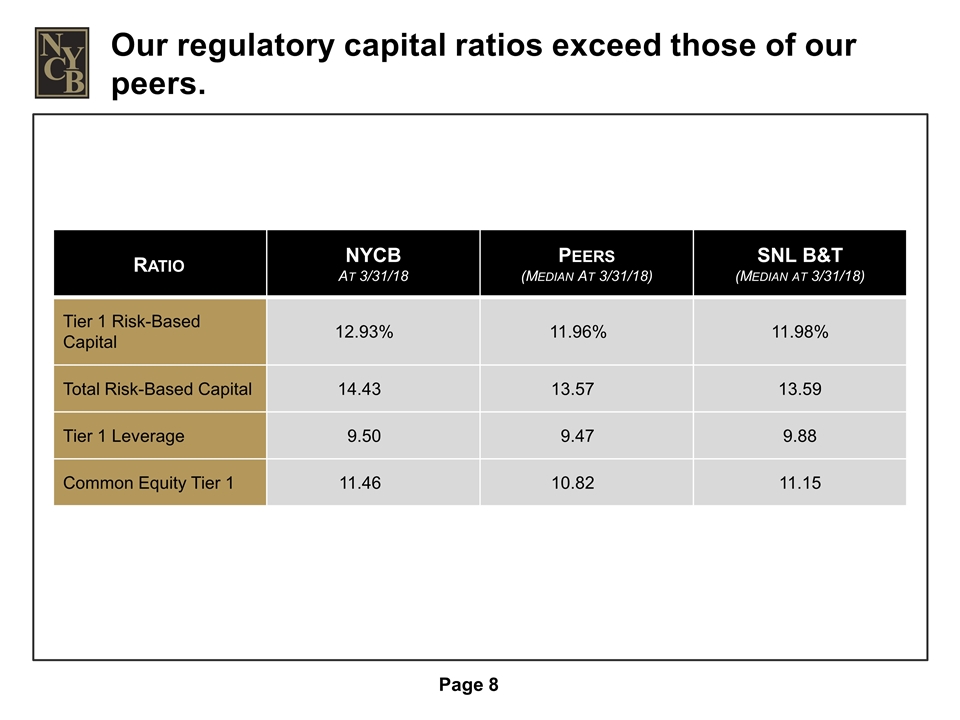
Our regulatory capital ratios exceed those of our peers. Ratio NYCB At 3/31/18 Peers (Median At 3/31/18) SNL B&T (Median at 3/31/18) Tier 1 Risk-Based Capital 12.93% 11.96% 11.98% Total Risk-Based Capital 14.43 13.57 13.59 Tier 1 Leverage 9.50 9.47 9.88 Common Equity Tier 1 11.46 10.82 11.15

Looking Forward
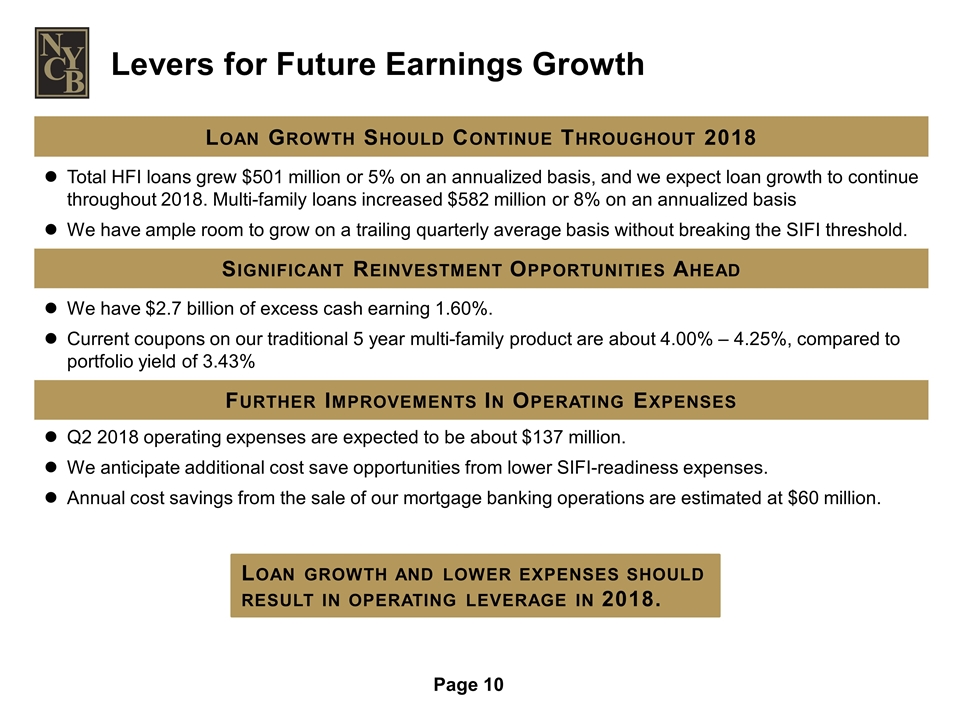
Loan Growth Should Continue Throughout 2018 Total HFI loans grew $501 million or 5% on an annualized basis, and we expect loan growth to continue throughout 2018. Multi-family loans increased $582 million or 8% on an annualized basis We have ample room to grow on a trailing quarterly average basis without breaking the SIFI threshold. Significant Reinvestment Opportunities Ahead We have $2.7 billion of excess cash earning 1.60%. Current coupons on our traditional 5 year multi-family product are about 4.00% – 4.25%, compared to portfolio yield of 3.43% Further Improvements In Operating Expenses Q2 2018 operating expenses are expected to be about $137 million. We anticipate additional cost save opportunities from lower SIFI-readiness expenses. Annual cost savings from the sale of our mortgage banking operations are estimated at $60 million. Levers for Future Earnings Growth Loan growth and lower expenses should result in operating leverage in 2018.
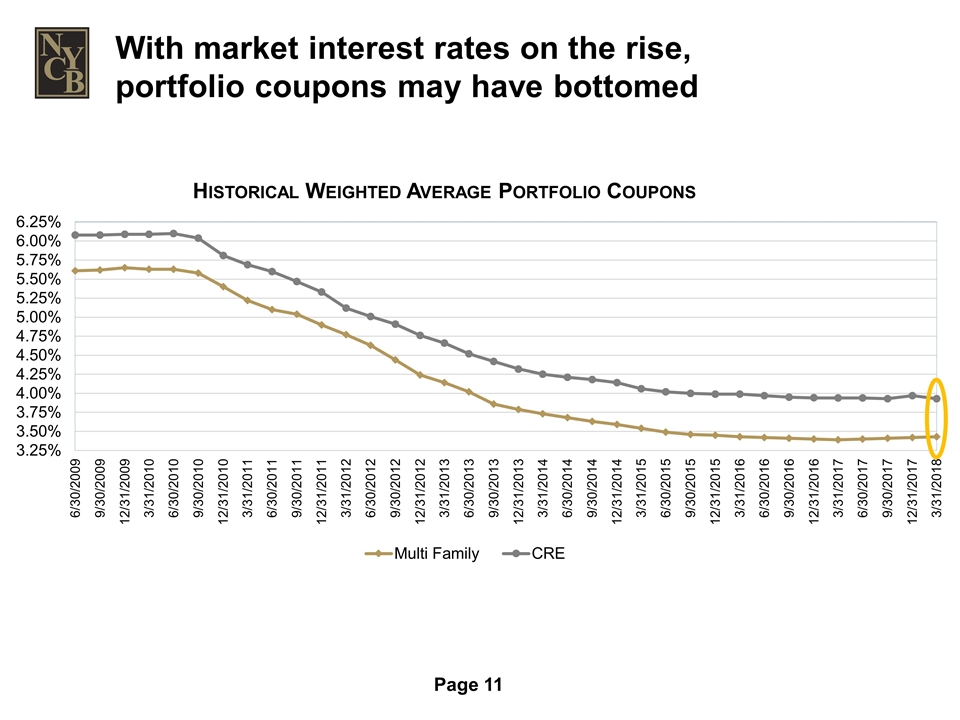
With market interest rates on the rise, portfolio coupons may have bottomed
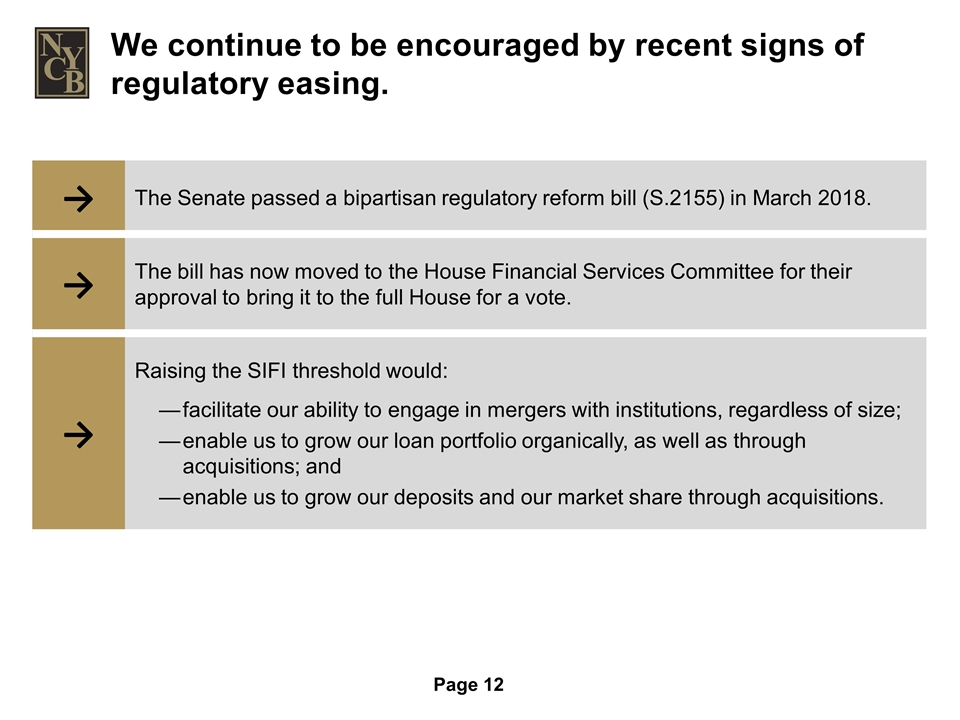
→ The Senate passed a bipartisan regulatory reform bill (S.2155) in March 2018. → The bill has now moved to the House Financial Services Committee for their approval to bring it to the full House for a vote. → Raising the SIFI threshold would: facilitate our ability to engage in mergers with institutions, regardless of size; enable us to grow our loan portfolio organically, as well as through acquisitions; and enable us to grow our deposits and our market share through acquisitions. We continue to be encouraged by recent signs of regulatory easing.
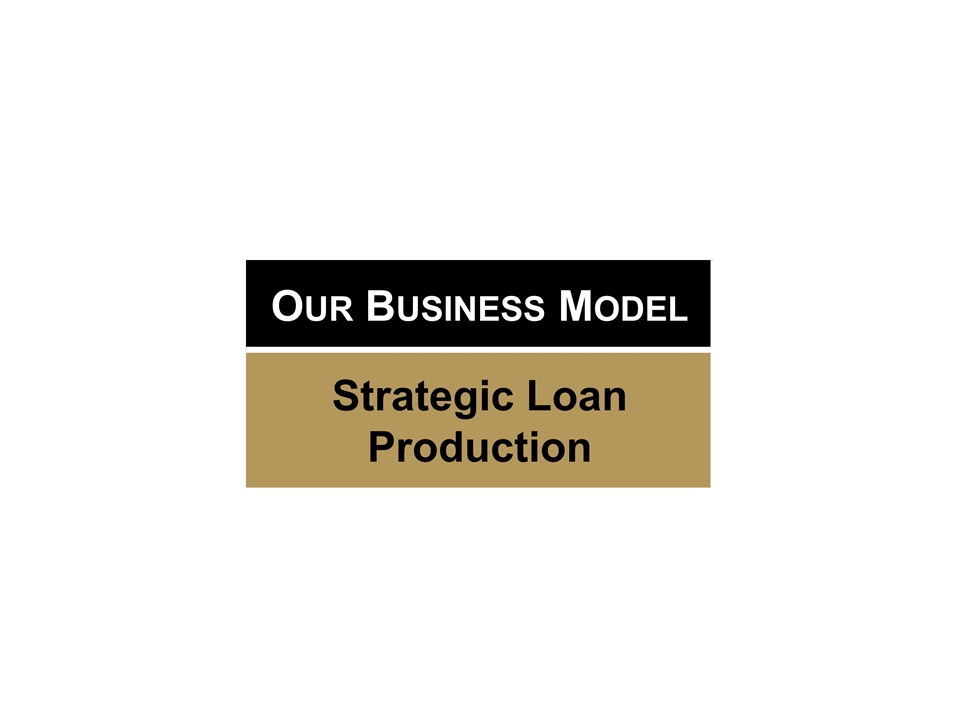
Our Business Model Strategic Loan Production
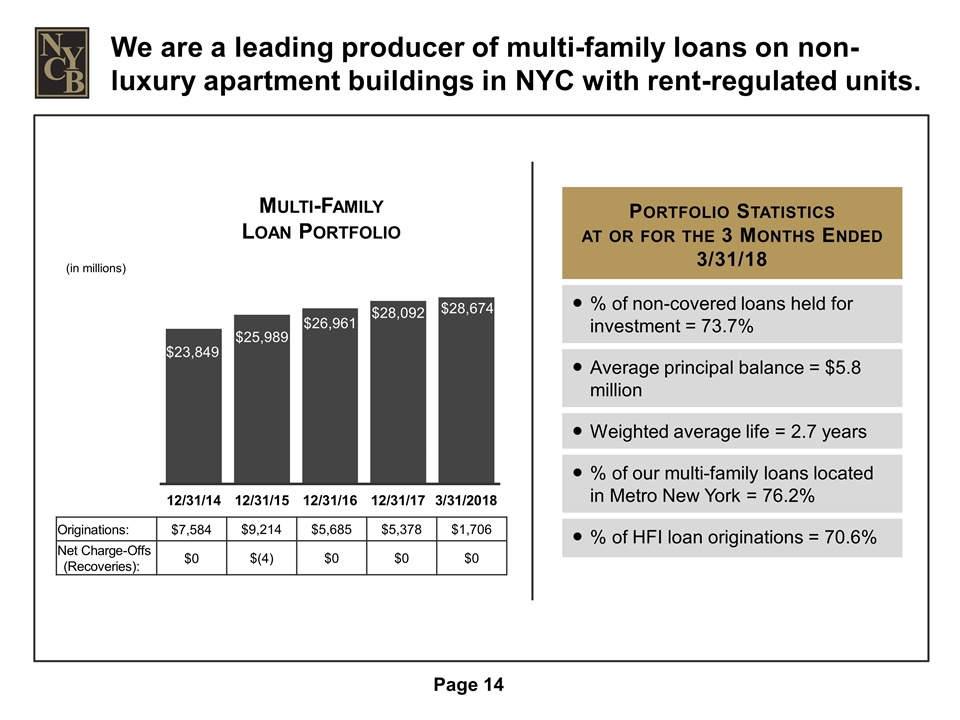
Portfolio Statistics at or for the 3 Months Ended 3/31/18 % of non-covered loans held for investment = 73.7% Average principal balance = $5.8 million Weighted average life = 2.7 years % of our multi-family loans located in Metro New York = 76.2% % of HFI loan originations = 70.6% Multi-Family Loan Portfolio (in millions) Originations: $7,584 $9,214 $5,685 $5,378 $1,706 Net Charge-Offs (Recoveries): $0 $(4) $0 $0 $0 We are a leading producer of multi-family loans on non-luxury apartment buildings in NYC with rent-regulated units.
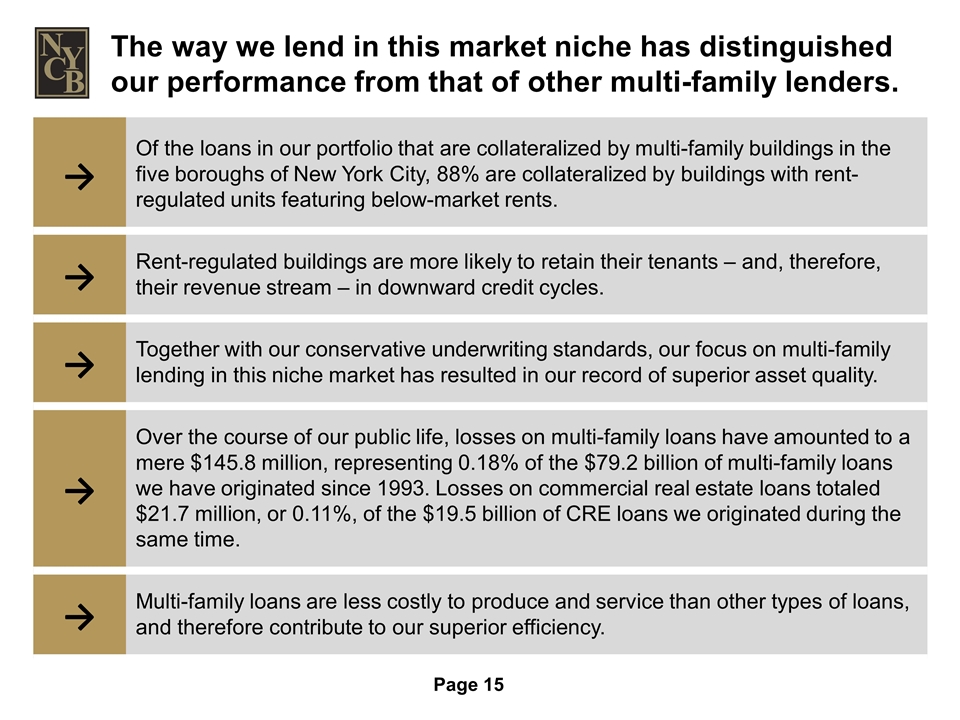
→ Of the loans in our portfolio that are collateralized by multi-family buildings in the five boroughs of New York City, 88% are collateralized by buildings with rent-regulated units featuring below-market rents. → Rent-regulated buildings are more likely to retain their tenants – and, therefore, their revenue stream – in downward credit cycles. → Together with our conservative underwriting standards, our focus on multi-family lending in this niche market has resulted in our record of superior asset quality. → Over the course of our public life, losses on multi-family loans have amounted to a mere $145.8 million, representing 0.18% of the $79.2 billion of multi-family loans we have originated since 1993. Losses on commercial real estate loans totaled $21.7 million, or 0.11%, of the $19.5 billion of CRE loans we originated during the same time. → Multi-family loans are less costly to produce and service than other types of loans, and therefore contribute to our superior efficiency. The way we lend in this market niche has distinguished our performance from that of other multi-family lenders.
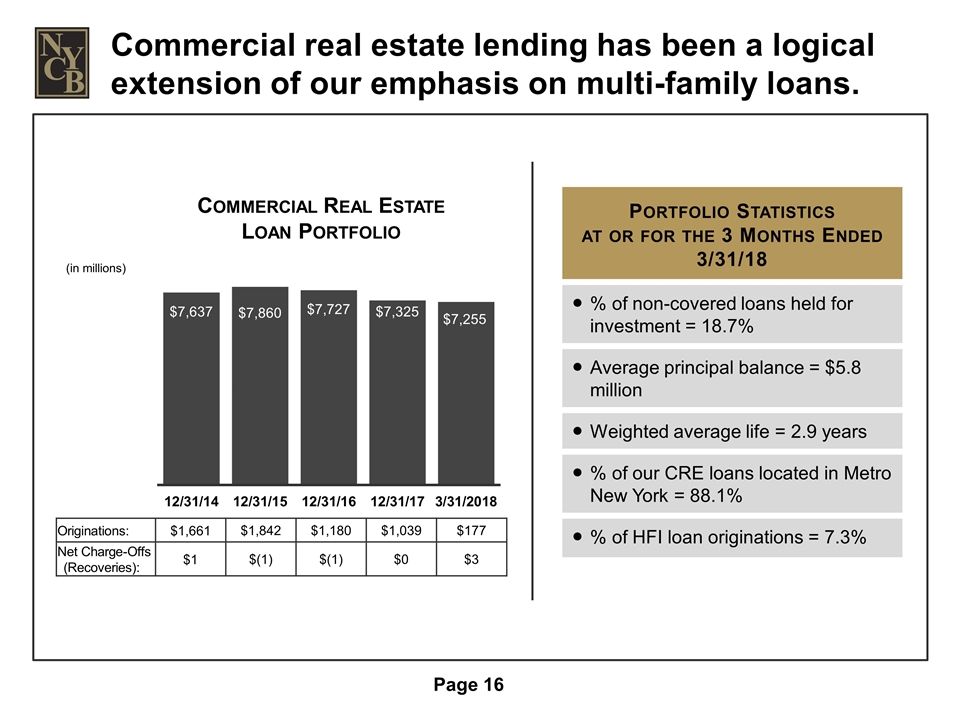
Commercial Real Estate Loan Portfolio (in millions) Originations: $1,661 $1,842 $1,180 $1,039 $177 Net Charge-Offs (Recoveries): $1 $(1) $(1) $0 $3 Commercial real estate lending has been a logical extension of our emphasis on multi-family loans. Portfolio Statistics at or for the 3 Months Ended 3/31/18 % of non-covered loans held for investment = 18.7% Average principal balance = $5.8 million Weighted average life = 2.9 years % of our CRE loans located in Metro New York = 88.1% % of HFI loan originations = 7.3%
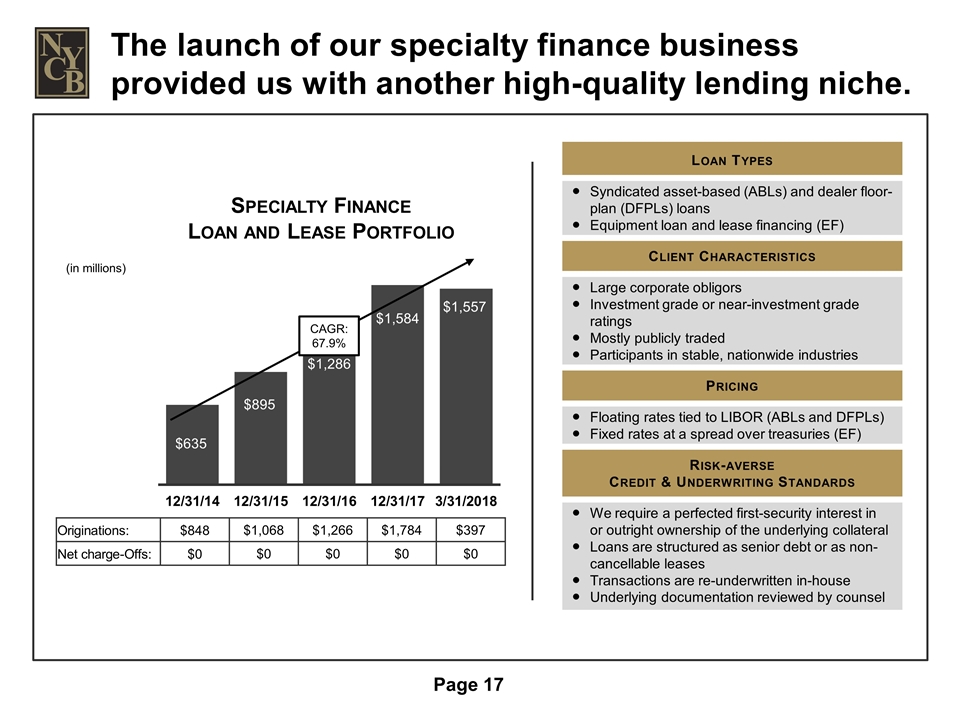
Specialty Finance Loan and Lease Portfolio (in millions) Originations: $848 $1,068 $1,266 $1,784 $397 Net charge-Offs: $0 $0 $0 $0 $0 The launch of our specialty finance business provided us with another high-quality lending niche. Loan Types Syndicated asset-based (ABLs) and dealer floor-plan (DFPLs) loans Equipment loan and lease financing (EF) Client Characteristics Large corporate obligors Investment grade or near-investment grade ratings Mostly publicly traded Participants in stable, nationwide industries Pricing Floating rates tied to LIBOR (ABLs and DFPLs) Fixed rates at a spread over treasuries (EF) Risk-averse Credit & Underwriting Standards We require a perfected first-security interest in or outright ownership of the underlying collateral Loans are structured as senior debt or as non-cancellable leases Transactions are re-underwritten in-house Underlying documentation reviewed by counsel CAGR: 67.9%
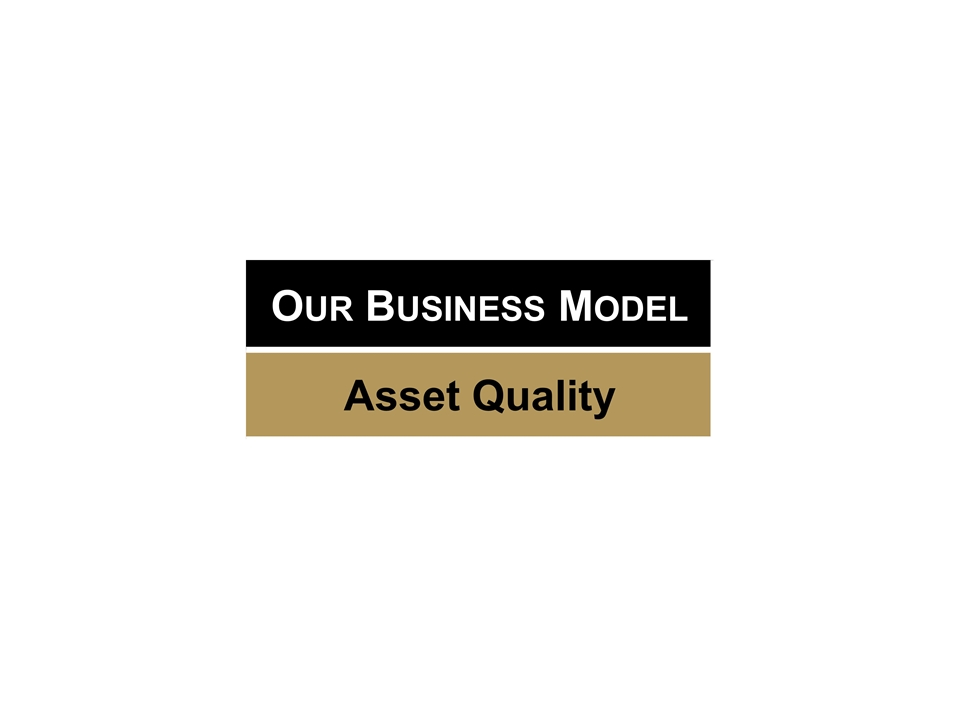
Our Business Model Asset Quality
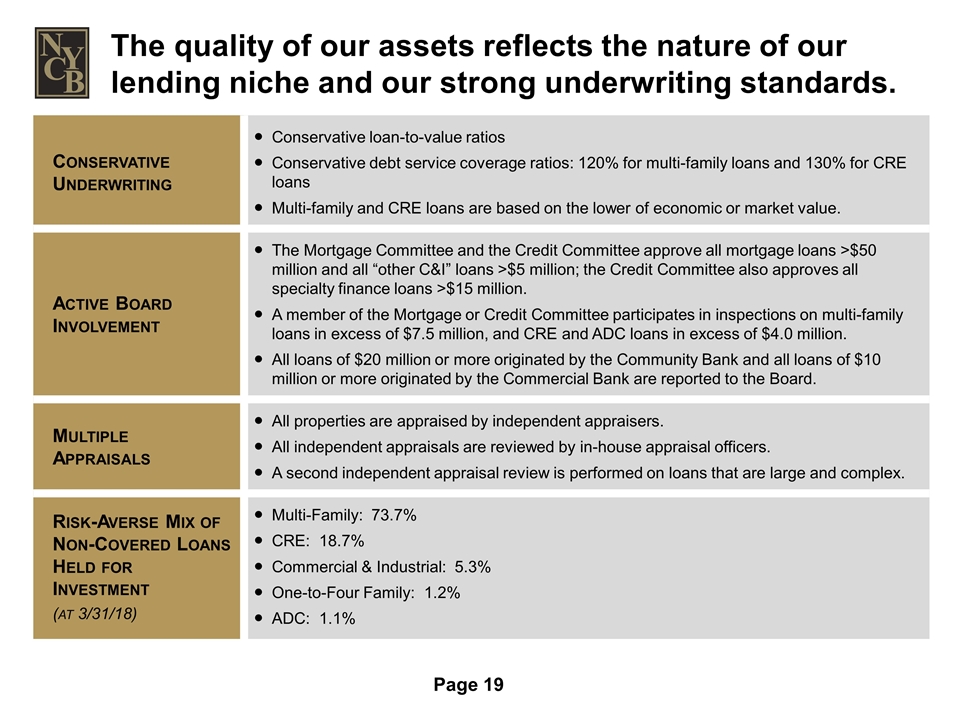
Conservative Underwriting Conservative loan-to-value ratios Conservative debt service coverage ratios: 120% for multi-family loans and 130% for CRE loans Multi-family and CRE loans are based on the lower of economic or market value. Active Board Involvement The Mortgage Committee and the Credit Committee approve all mortgage loans >$50 million and all “other C&I” loans >$5 million; the Credit Committee also approves all specialty finance loans >$15 million. A member of the Mortgage or Credit Committee participates in inspections on multi-family loans in excess of $7.5 million, and CRE and ADC loans in excess of $4.0 million. All loans of $20 million or more originated by the Community Bank and all loans of $10 million or more originated by the Commercial Bank are reported to the Board. Multiple Appraisals All properties are appraised by independent appraisers. All independent appraisals are reviewed by in-house appraisal officers. A second independent appraisal review is performed on loans that are large and complex. Risk-Averse Mix of Non-Covered Loans Held for Investment (at 3/31/18) Multi-Family: 73.7% CRE: 18.7% Commercial & Industrial: 5.3% One-to-Four Family: 1.2% ADC: 1.1% The quality of our assets reflects the nature of our lending niche and our strong underwriting standards.
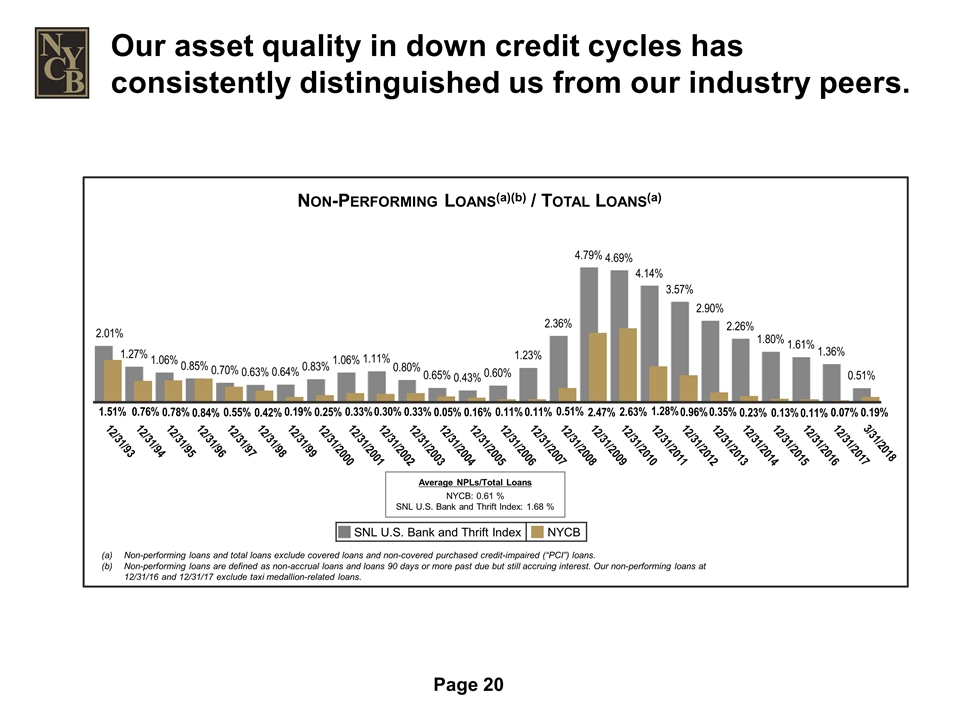
Non-Performing Loans(a)(b) / Total Loans(a) Non-performing loans and total loans exclude covered loans and non-covered purchased credit-impaired (“PCI”) loans. Non-performing loans are defined as non-accrual loans and loans 90 days or more past due but still accruing interest. Our non-performing loans at 12/31/16 and 12/31/17 exclude taxi medallion-related loans. Average NPLs/Total Loans NYCB: 0.61 % SNL U.S. Bank and Thrift Index: 1.68 % SNL U.S. Bank and Thrift Index NYCB Our asset quality in down credit cycles has consistently distinguished us from our industry peers.
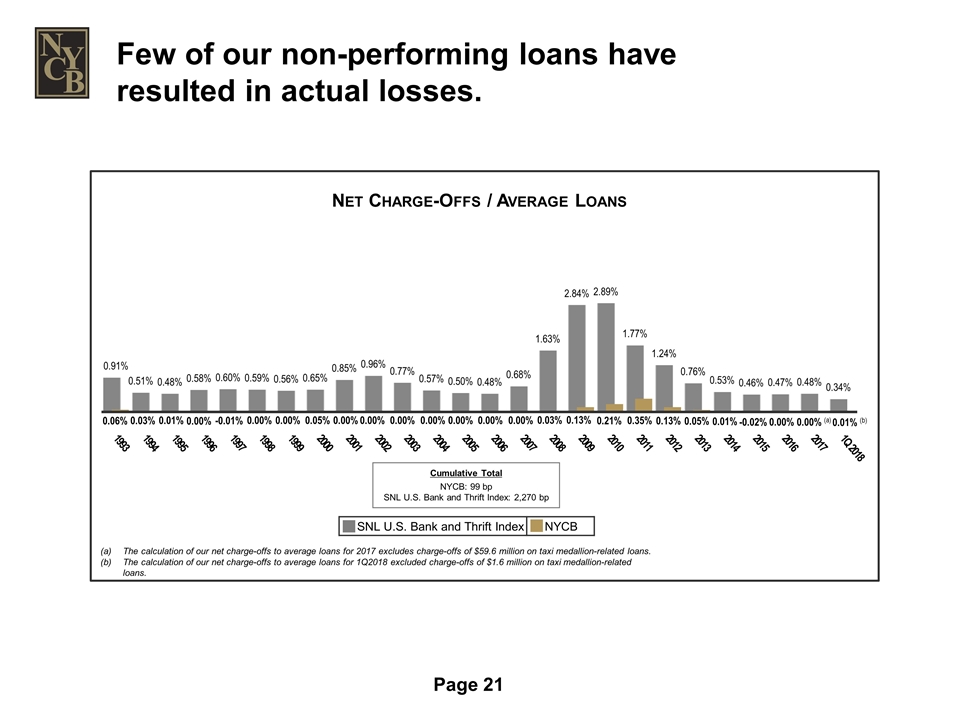
Few of our non-performing loans have resulted in actual losses. Net Charge-Offs / Average Loans Cumulative Total NYCB: 99 bp SNL U.S. Bank and Thrift Index: 2,270 bp The calculation of our net charge-offs to average loans for 2017 excludes charge-offs of $59.6 million on taxi medallion-related loans. The calculation of our net charge-offs to average loans for 1Q2018 excluded charge-offs of $1.6 million on taxi medallion-related loans. SNL U.S. Bank and Thrift Index NYCB
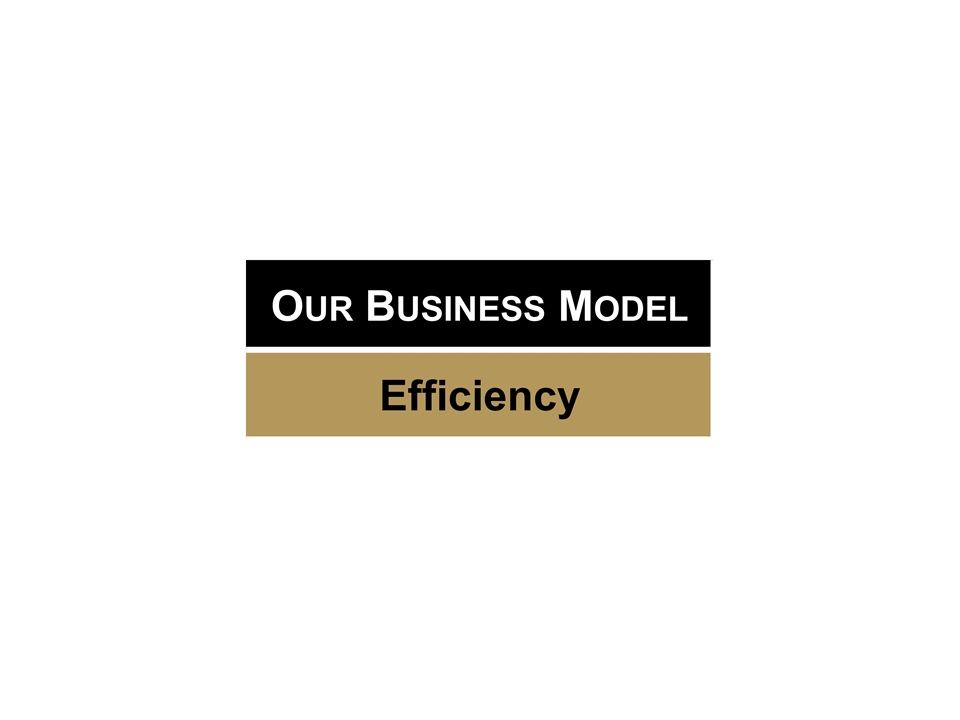
Our Business Model Efficiency
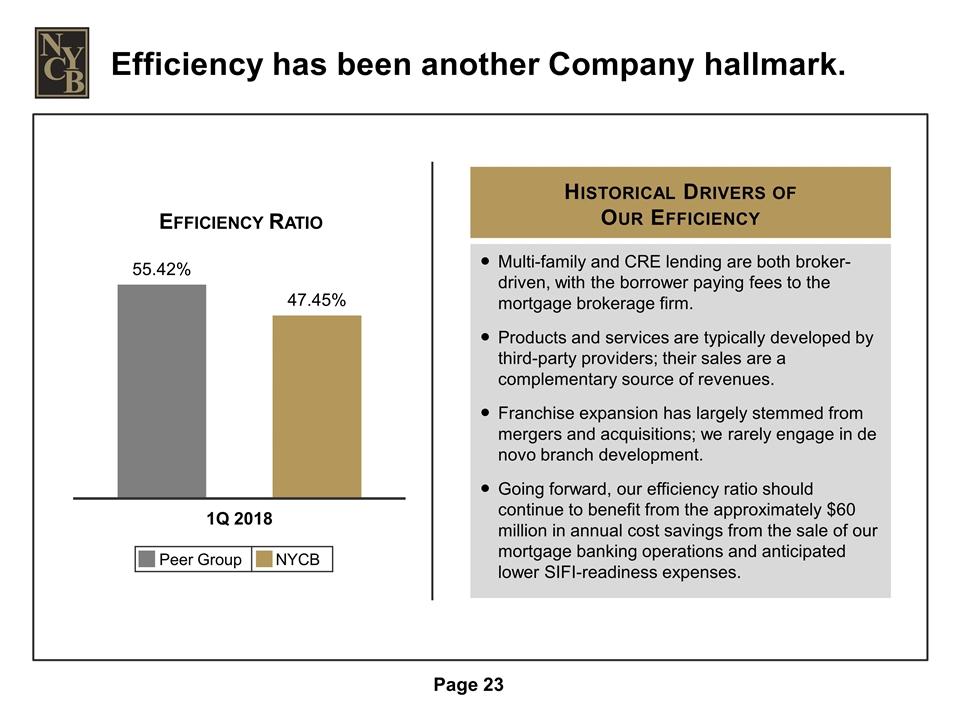
Efficiency has been another Company hallmark. Historical Drivers of Our Efficiency Multi-family and CRE lending are both broker-driven, with the borrower paying fees to the mortgage brokerage firm. Products and services are typically developed by third-party providers; their sales are a complementary source of revenues. Franchise expansion has largely stemmed from mergers and acquisitions; we rarely engage in de novo branch development. Going forward, our efficiency ratio should continue to benefit from the approximately $60 million in annual cost savings from the sale of our mortgage banking operations and anticipated lower SIFI-readiness expenses. Efficiency Ratio Peer Group NYCB
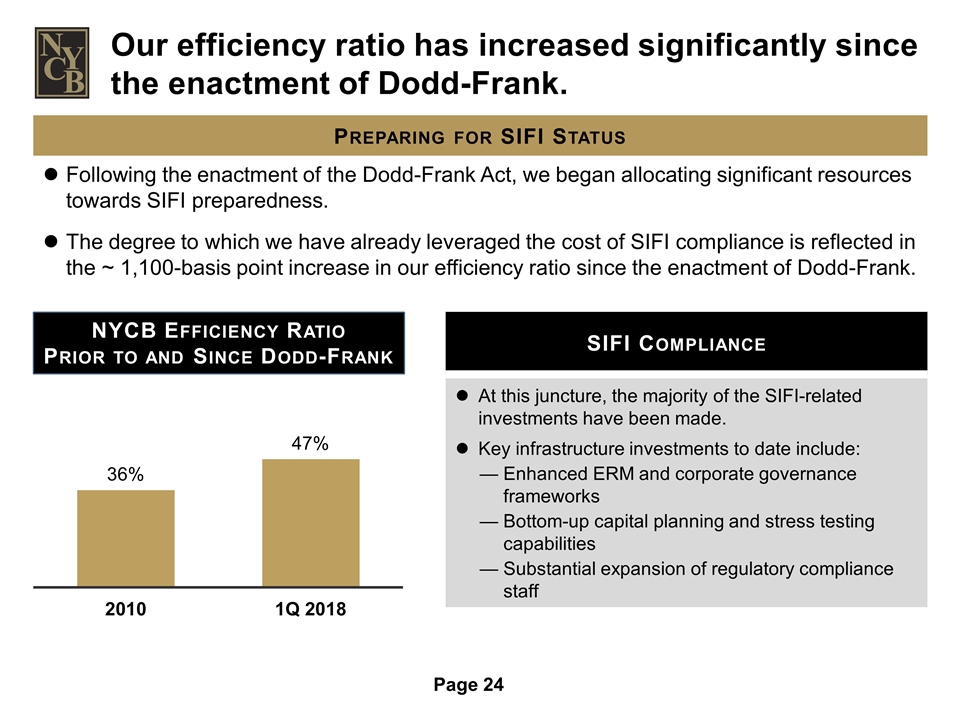
NYCB Efficiency Ratio Prior to and Since Dodd-Frank SIFI Compliance At this juncture, the majority of the SIFI-related investments have been made. Key infrastructure investments to date include: Enhanced ERM and corporate governance frameworks Bottom-up capital planning and stress testing capabilities Substantial expansion of regulatory compliance staff Preparing for SIFI Status Following the enactment of the Dodd-Frank Act, we began allocating significant resources towards SIFI preparedness. The degree to which we have already leveraged the cost of SIFI compliance is reflected in the ~ 1,100-basis point increase in our efficiency ratio since the enactment of Dodd-Frank. Our efficiency ratio has increased significantly since the enactment of Dodd-Frank.
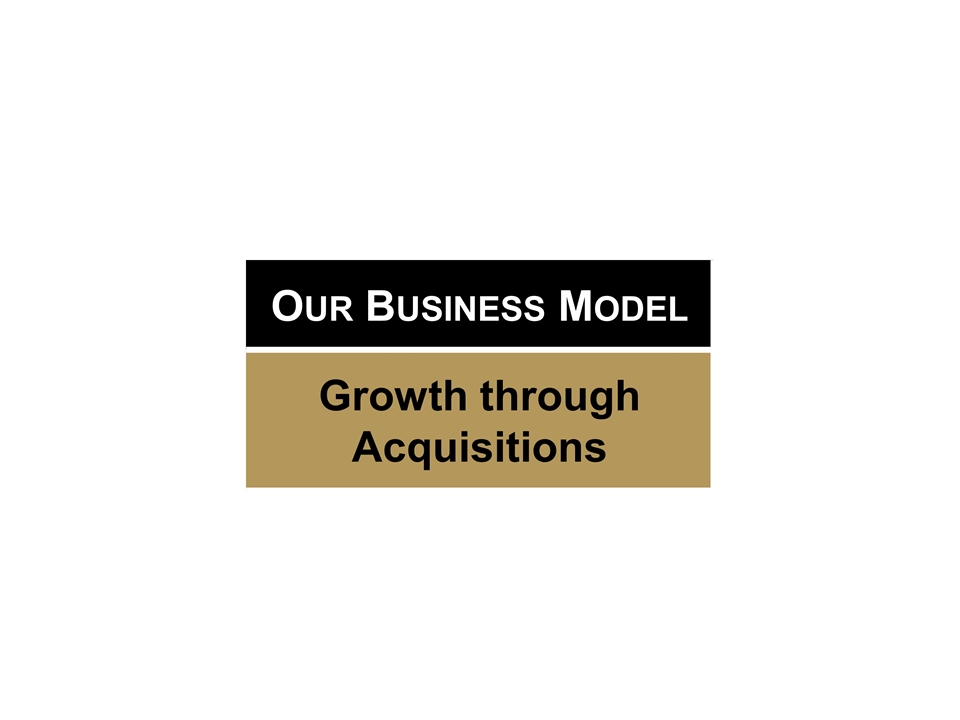
Our Business Model Growth through Acquisitions
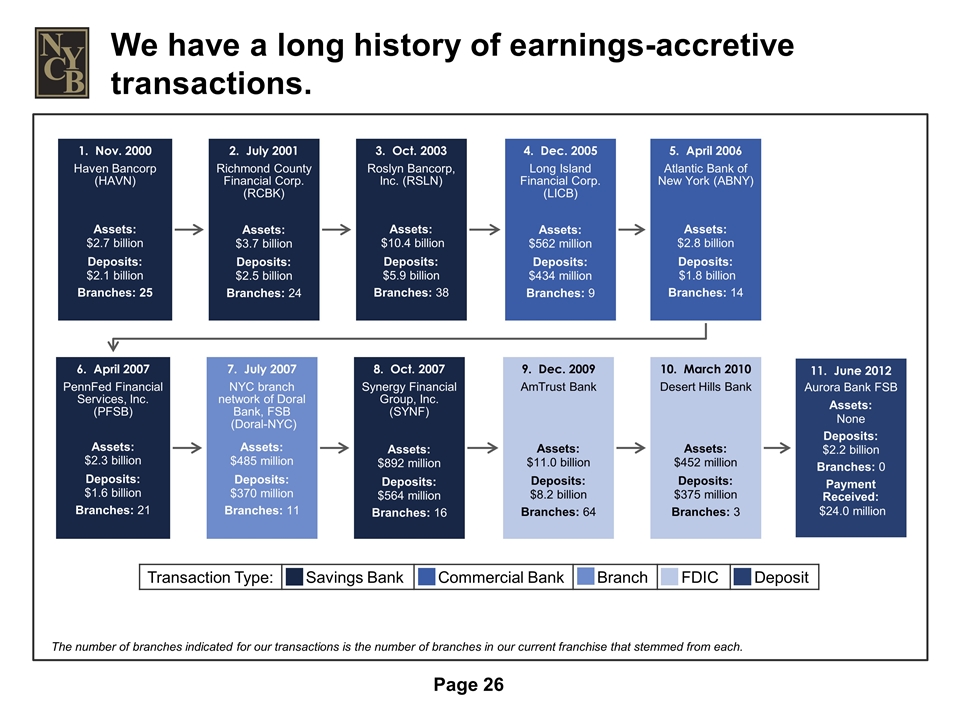
Transaction Type: Savings Bank Commercial Bank Branch FDIC Deposit We have a long history of earnings-accretive transactions. The number of branches indicated for our transactions is the number of branches in our current franchise that stemmed from each. 1. Nov. 2000 Haven Bancorp (HAVN) Assets: $2.7 billion Deposits: $2.1 billion Branches: 25 3. Oct. 2003 Roslyn Bancorp, Inc. (RSLN) Assets: $10.4 billion Deposits: $5.9 billion Branches: 38 4. Dec. 2005 Long Island Financial Corp. (LICB) Assets: $562 million Deposits: $434 million Branches: 9 2. July 2001 Richmond County Financial Corp. (RCBK) Assets: $3.7 billion Deposits: $2.5 billion Branches: 24 5. April 2006 Atlantic Bank of New York (ABNY) Assets: $2.8 billion Deposits: $1.8 billion Branches: 14 6. April 2007 PennFed Financial Services, Inc. (PFSB) Assets: $2.3 billion Deposits: $1.6 billion Branches: 21 7. July 2007 NYC branch network of Doral Bank, FSB (Doral-NYC) Assets: $485 million Deposits: $370 million Branches: 11 8. Oct. 2007 Synergy Financial Group, Inc. (SYNF) Assets: $892 million Deposits: $564 million Branches: 16 9. Dec. 2009 AmTrust Bank Assets: $11.0 billion Deposits: $8.2 billion Branches: 64 10. March 2010 Desert Hills Bank Assets: $452 million Deposits: $375 million Branches: 3 11. June 2012 Aurora Bank FSB Assets: None Deposits: $2.2 billion Branches: 0 Payment Received: $24.0 million
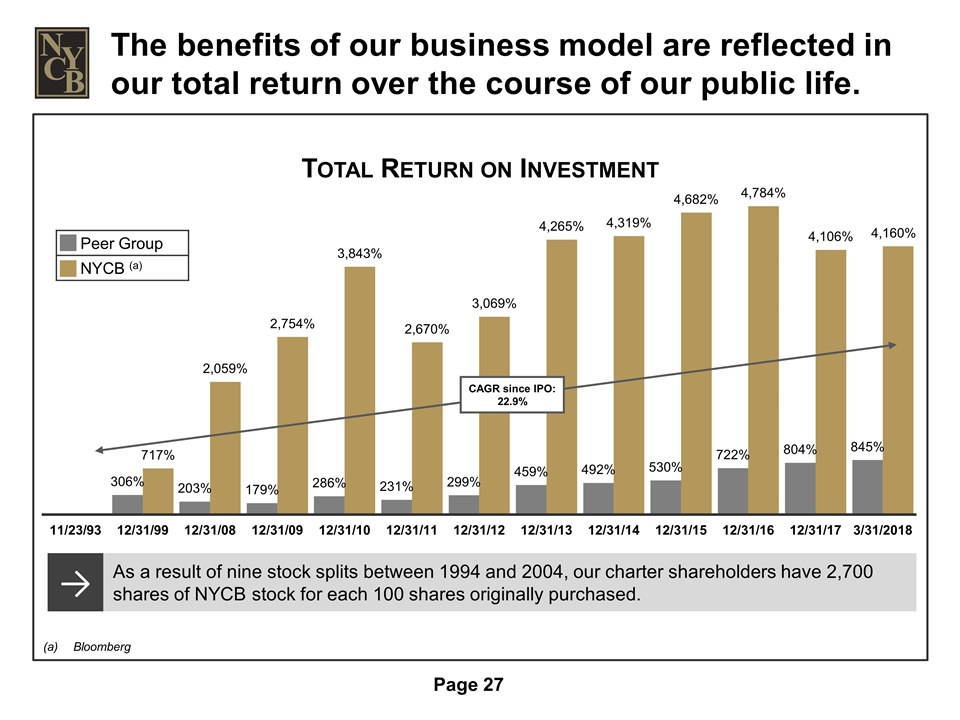
The benefits of our business model are reflected in our total return over the course of our public life. Total Return on Investment Bloomberg CAGR since IPO: 22.9% → As a result of nine stock splits between 1994 and 2004, our charter shareholders have 2,700 shares of NYCB stock for each 100 shares originally purchased. Peer Group NYCB (a)
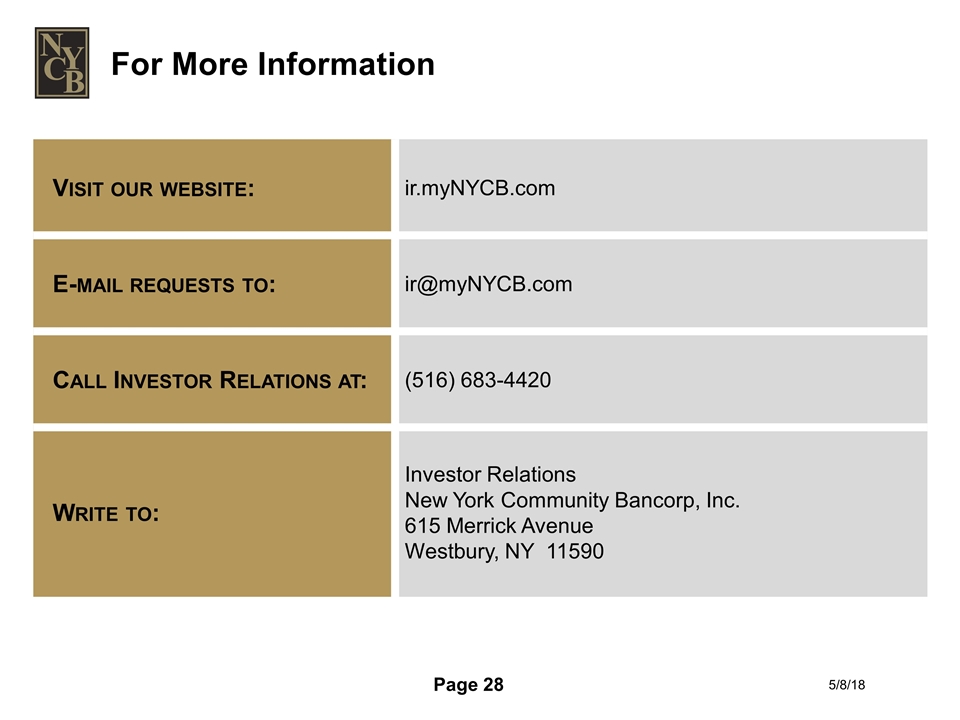
5/8/18 Visit our website: ir.myNYCB.com E-mail requests to: ir@myNYCB.com Call Investor Relations at: (516) 683-4420 Write to: Investor Relations New York Community Bancorp, Inc. 615 Merrick Avenue Westbury, NY 11590 For More Information
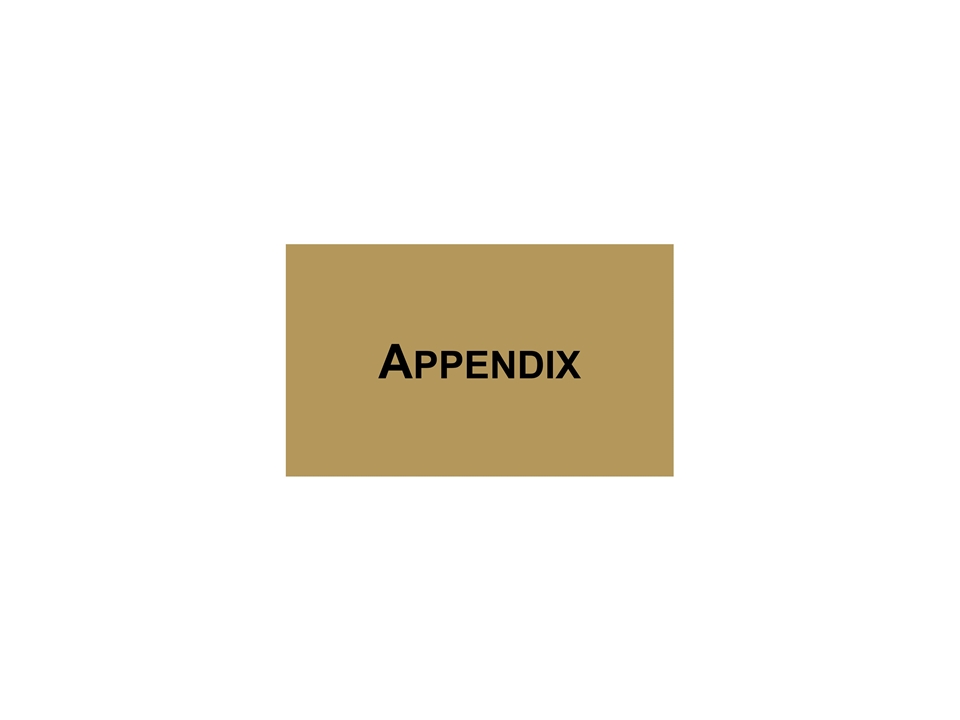
Appendix
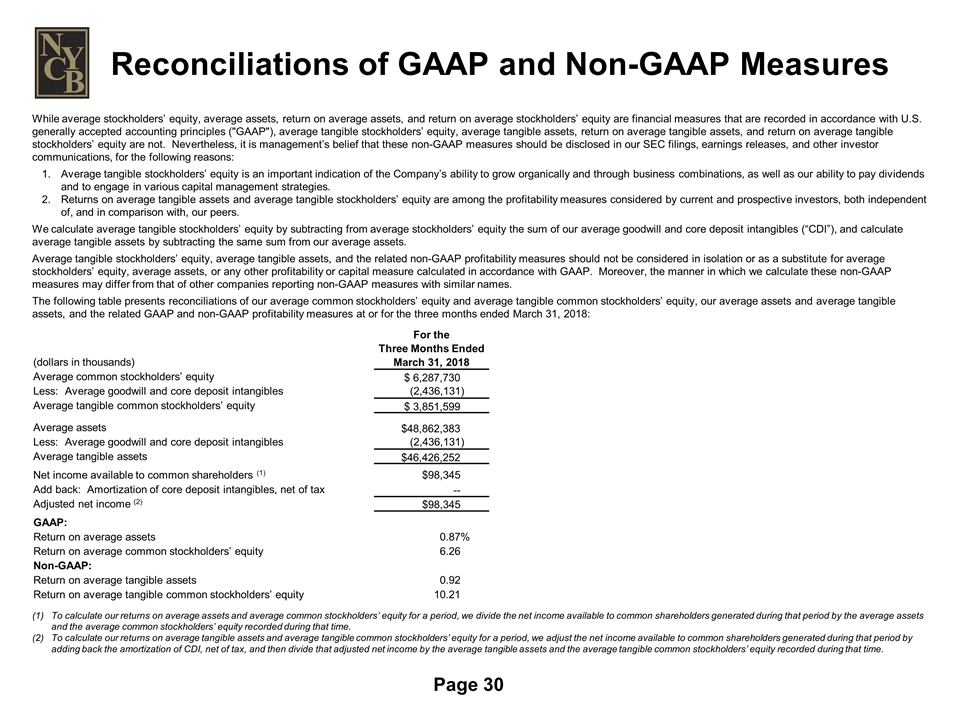
While average stockholders’ equity, average assets, return on average assets, and return on average stockholders’ equity are financial measures that are recorded in accordance with U.S. generally accepted accounting principles ("GAAP"), average tangible stockholders’ equity, average tangible assets, return on average tangible assets, and return on average tangible stockholders’ equity are not. Nevertheless, it is management’s belief that these non-GAAP measures should be disclosed in our SEC filings, earnings releases, and other investor communications, for the following reasons: Average tangible stockholders’ equity is an important indication of the Company’s ability to grow organically and through business combinations, as well as our ability to pay dividends and to engage in various capital management strategies. Returns on average tangible assets and average tangible stockholders’ equity are among the profitability measures considered by current and prospective investors, both independent of, and in comparison with, our peers. We calculate average tangible stockholders’ equity by subtracting from average stockholders’ equity the sum of our average goodwill and core deposit intangibles (“CDI”), and calculate average tangible assets by subtracting the same sum from our average assets. Average tangible stockholders’ equity, average tangible assets, and the related non-GAAP profitability measures should not be considered in isolation or as a substitute for average stockholders’ equity, average assets, or any other profitability or capital measure calculated in accordance with GAAP. Moreover, the manner in which we calculate these non-GAAP measures may differ from that of other companies reporting non-GAAP measures with similar names. The following table presents reconciliations of our average common stockholders’ equity and average tangible common stockholders’ equity, our average assets and average tangible assets, and the related GAAP and non-GAAP profitability measures at or for the three months ended March 31, 2018: To calculate our returns on average assets and average common stockholders’ equity for a period, we divide the net income available to common shareholders generated during that period by the average assets and the average common stockholders’ equity recorded during that time. To calculate our returns on average tangible assets and average tangible common stockholders’ equity for a period, we adjust the net income available to common shareholders generated during that period by adding back the amortization of CDI, net of tax, and then divide that adjusted net income by the average tangible assets and the average tangible common stockholders’ equity recorded during that time. Reconciliations of GAAP and Non-GAAP Measures (dollars in thousands) For the Three Months Ended March 31, 2018 Average common stockholders’ equity $ 6,287,730 Less: Average goodwill and core deposit intangibles (2,436,131) Average tangible common stockholders’ equity $ 3,851,599 Average assets $48,862,383 Less: Average goodwill and core deposit intangibles (2,436,131) Average tangible assets $46,426,252 Net income available to common shareholders (1) $98,345 Add back: Amortization of core deposit intangibles, net of tax -- Adjusted net income (2) $98,345 GAAP: Return on average assets 0.87% Return on average common stockholders’ equity 6.26 Non-GAAP: Return on average tangible assets 0.92 Return on average tangible common stockholders’ equity 10.21
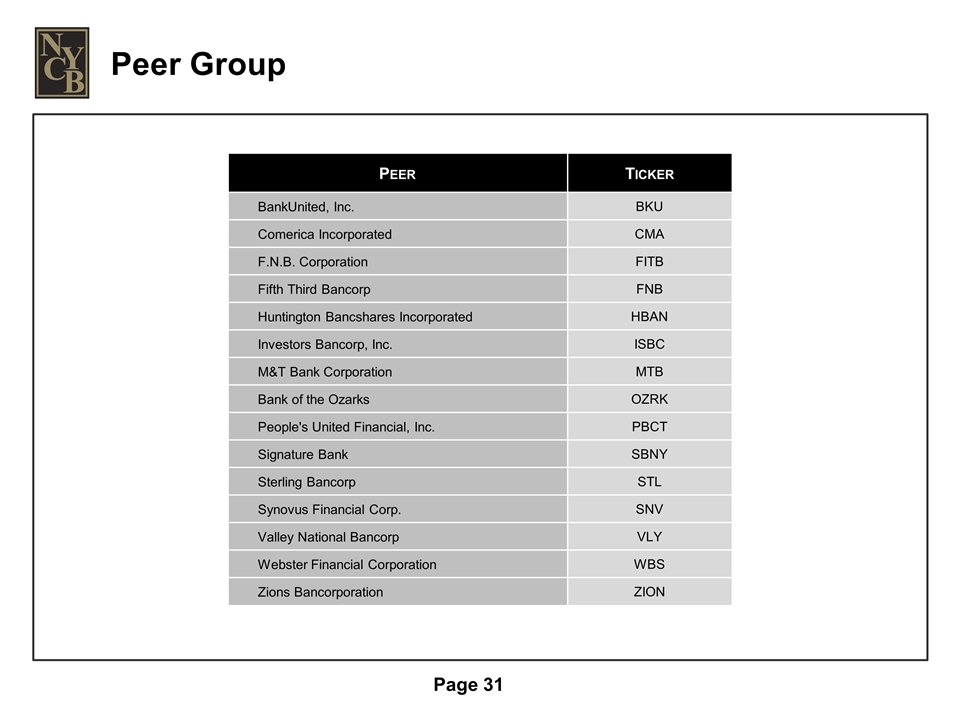
Peer Group Peer Ticker BankUnited, Inc. BKU Comerica Incorporated CMA F.N.B. Corporation FITB Fifth Third Bancorp FNB Huntington Bancshares Incorporated HBAN Investors Bancorp, Inc. ISBC M&T Bank Corporation MTB Bank of the Ozarks OZRK People's United Financial, Inc. PBCT Signature Bank SBNY Sterling Bancorp STL Synovus Financial Corp. SNV Valley National Bancorp VLY Webster Financial Corporation WBS Zions Bancorporation ZION